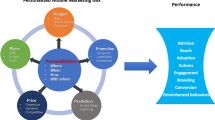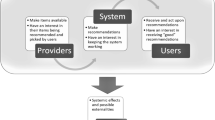Abstract
In this study, we established a novel set of service procedures that epitomize the human-centered spirit of service. By using self-organizing maps and collaborative filtering recommendation, we developed a mechanism that links the two service procedures of selecting service staff members and how customers decide tip amounts based on perceived value. Through the proposed mechanism, the recommender system could effectively predict customer preferences regarding service staff members and assign suitable members for delivering services. In addition, this study integrated the service experiences of previous customers with local tipping cultures for calculating recommended tip amounts for the reference of customers. Under this mechanism, the customer-centered spirit can be completely integrated into service procedures for effectively enhancing customer satisfaction, increasing the job satisfaction of employees, and producing a virtuous cycle of service quality improvement.






Similar content being viewed by others
References
Artuğer, S., & Çetinsöz, B. C. (2013). Factors influencing the tipping propensity of restaurant customers: a atudy in 5 Star Hotels aLa Carte Restaurants. International Journal of Business and Social Science, 4(17), 70–78.
Artuğer, S., & Çetinsöz, B. C. (2014). A research for determining the relationship between destination image and destination personality. Journal of Business Research (Turk), 6(1), 366–384.
Barragáns-Martínez, A. B., Costa-Montenegro, E., Burguillo, J. C., Rey-López, M., Mikic-Fonte, F. A., & Peleteiro, A. (2010). A hybrid content-based and item-based collaborative filtering approach to recommend TV programs enhanced with singular value decomposition. Information Sciences, 180, 4290–4311.
Chang, W. L. (2014). Service mining framework and application. NY: Business Expert Press.
Chang, P. C., & Lai, C. Y. (2005). A hybrid system combining self-organizing maps with case-based reasoning in wholesaler’s new-release book forecasting. Expert Systems with Applications, 29, 183–192.
Chen, N., Ribeiro, B., Vieira, A., & Chen, A. (2013). Clustering and visualization of bankruptcy trajectory using self-organizing map. Expert Systems with Applications, 40, 385–393.
Fiedler, F. E. (1967). A theory of leadership effectiveness. New York: McGraw-Hill.
Fung, C. K., & Hung, C. K. (2013). Information and knowledge management in online rich presence services. Information Systems Frontiers, 15(4), 521–523.
Goldberg, D., Nichols, D., Oki, B. M., & Terry, D. (1992). Using collaborative filtering to weave an information tapestry. Communications of the ACM, 35(12), 61–70.
Grönroos, C. (1984). A service quality model and its marketing implications. European Journal of Marketing, 18(4), 37–45.
Hajek, P., Henriques, R., & Hajkova, V. (2013). Visualising components of regional innovation systems using self-organizing maps—Evidence from European regions. Technological Forecasting and Social Change, 84, 197–214.
Hoffman, K. D., & Ingram, T. N. (1992). Service provider job satisfaction and customer-oriented performance. Journal of Services Marketing, 6(2), 68–78.
Homans, G. (1961). Social behavior: Its elementary forms. New York: Harcourt Brace.
Juran, J. M. (1988). Juran on planning for quality. New York: Free Press.
Kauko, T. (2007). A heterodox economic analysis of the housing market structure in budapest using neural network classification. Journal of Real Estate Literature, 15(1), 87–124.
Keaveney, S. M. (1995). Customer switching behavior in service industries: an exploratory study. Journal of Marketing, 59(April), 71–82.
Länsiluoto, A., & Eklund, T. (2008). On the suitability of the self-organizing map for analysis of the macro and firm level competitive environment. Business Intelligence Journal, 15(4), 402–419.
Lee, H. J., & Park, S. J. (2007). MONERS: a news recommender for the mobile web. Expert Systems with Applications, 32, 143–150.
Lee, S. K., Cho, Y. H., & Kim, S. H. (2010). Collaborative filtering with ordinal scale-based implicit ratings for mobile music recommendations. Information Sciences, 180, 2142–2155.
Lewis, E. B. (1982). In M. M. Burger & R. Weber (Eds.), Control of body segment differentiation in Drosophila by the Bithorax gene complex, embryonic development, part A: Genetic aspects (pp. 269–288). New York: Alan R. Liss.
Lin, I. Y., & Namasivayam, K. (2011). Understanding restaurant tipping systems: a human resources perspective. International Journal of Contemporary Hospitality Management, 23(7), 923–940.
Lin, A. J., Hsu, C. L., & Li, E. Y. (2014). Improving the effectiveness of experiential decisions by recommendation systems. Expert Systems with Applications, 41(10), 4904–4914.
Martín Guerrero, J. D., Marcelli, D., Soria-Olivas, E., Mari, F., Martínez-Martínez, J. M., Soley Bech, I., Martínez-Sober, M., Scatizzi, L., Gómez-Sanchis, J., Stopper, A., Serrano-López, A. J., & Gatti, E. (2012). Self-organising maps: a new way to screen the level of satisfaction of dialysis patients. Expert Systems with Applications, 39(10), 8793–8798.
Nilashi, M., Ibrahim, O., & Ithnin, N. (2014). Hybrid recommendation approaches for multi-criteria collaborative filtering. Expert Systems with Applications, 41(8), 3879–3900.
Resnick, P., Iacovou, N., Suchak, M., Bergstrom, P., & Riedl, J. G. (1994) An open architecture for collaborative filtering of netnews. In Proceedings of ACM CSCW’94 Conference on Computer-Supported Cooperative Work, pp. 175–186.
Rong, W., Peng, B., Ouyang, Y., Liu, K., & Xiong, Z. (2014). Collaborative personal profiling for web service ranking and recommendation. Information Systems Frontiers. doi:10.1007/s10796-014-9495-4.
Schneider, B., & Bowen, D. E. (1985). Employee and customer perception of service in banks: replication and extension. Journal of Applied Psychology, 70, 423–433.
Seret, A., Broucke, S. K. L. M. V., Baesens, B., & Vanthienen, J. (2014). A dynamic understanding of customer behavior processes based on clustering and sequence mining. Expert Systems with Applications, 41(10), 4648–4657.
Solomon, M. R., Surprenant, C., Czepiel, J. A., & Gutman, E. G. (1985). A role theory perspective on dyadic interactions: the service encounter. Journal of Marketing, 49(4), 99–111.
Wang, P. Y., & Yang, H. C. (2012). Using collaborative filtering to support college students’ use of online forum for English learning. Computers and Education, 59, 628–637.
Wei, J. T., Lee, M. C., Chen, H. K., & Wu, H. H. (2013). Customer relationship management in the hairdressing industry: an application of data mining techniques. Expert Systems with Applications, 40, 7513–7518.
Wiggins, J. L., Peltier, S. J., Ashinoff, S., Weng, S. J., Carrasco, M., Welsh, R. C., Lord, C., & Monk, C. S. (2011). Using a self-organizing map algorithm to detect age-related changes in functional connectivity during rest in autism spectrum disorders. Brain Research, 380, 187–197.
Winoto, P., Tang, T. Y., & McCalla, G. (2012). Context in a paper recommendation system with collaborative filtering. The International Review Research in Open and Distance Learning, 13(5), 56–75.
Wise, W. (2005). Tourism industry and development strategy. Applying ethical research communications, 36, 26–34.
Zhang, Y., Chen, W., & Yin, Z. (2013). Collaborative filtering with social regularization for TV program recommendation. Knowledge-Based Systems, 54, 310–317.
Author information
Authors and Affiliations
Corresponding author
Rights and permissions
About this article
Cite this article
Chang, WL., Jung, CF. A hybrid approach for personalized service staff recommendation. Inf Syst Front 19, 149–163 (2017). https://doi.org/10.1007/s10796-015-9597-7
Published:
Issue Date:
DOI: https://doi.org/10.1007/s10796-015-9597-7




